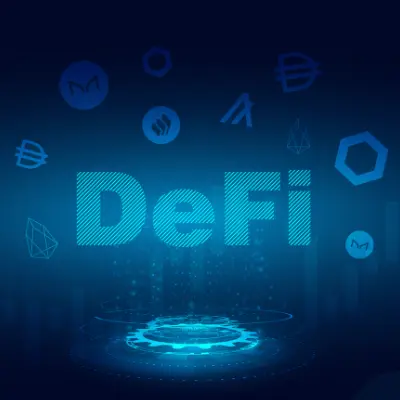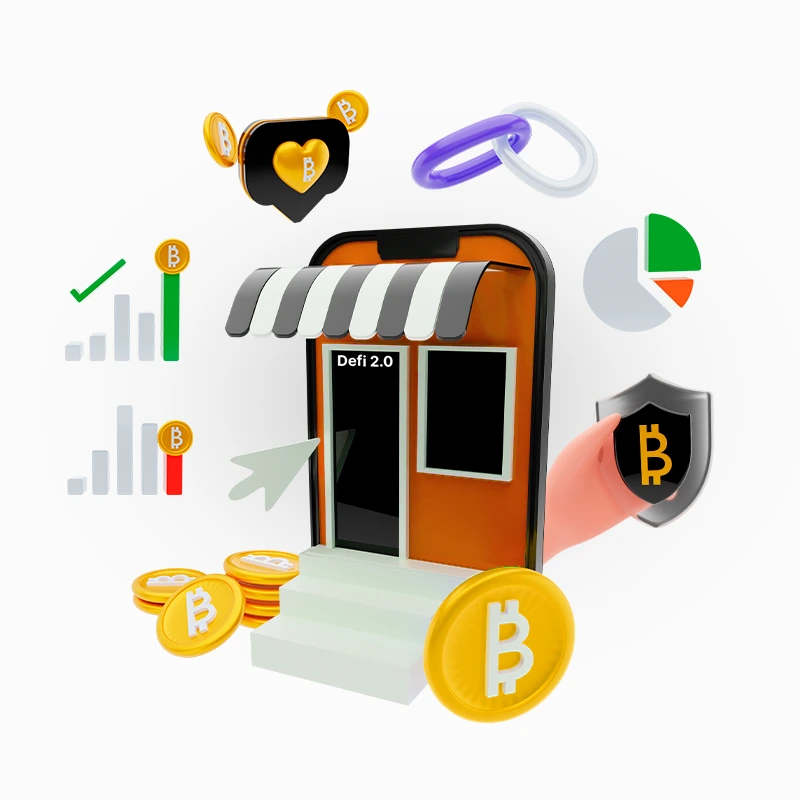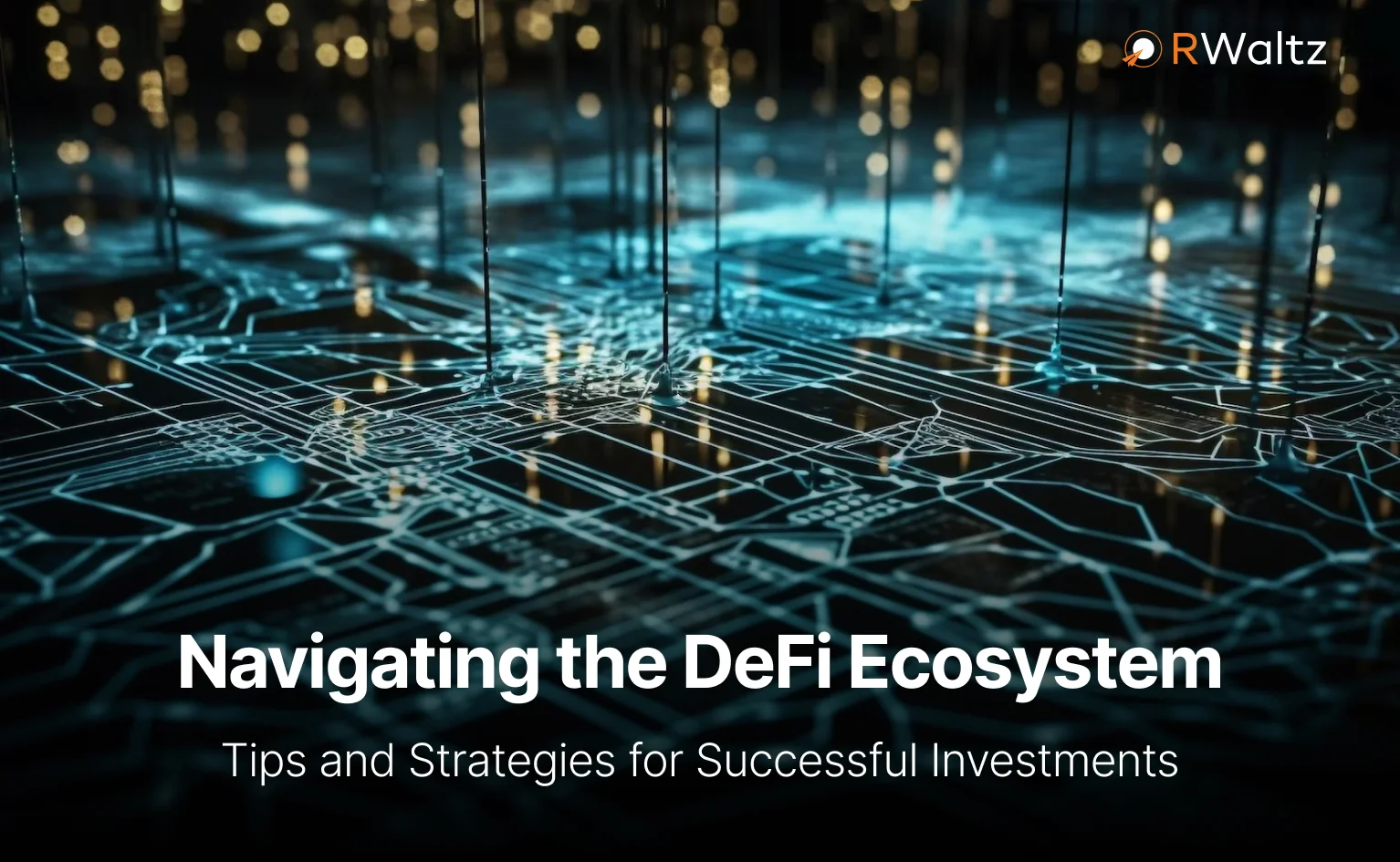Search Blogs

A 2022 Guide to Decentralized Finance Application
Decentralized Finance is reinventing the financial ecosystem facilitating a flexible and simple approach to access funds. Setting up new standards of access, resilience, and transparency; Defi is turning out to be a potential game-changer for the banking and finance sector. Let’s dive in deep to explore more about Decentralized Finance (Defi) What is Decentralized Finance (DeFi)? Decentralized Finance (Defi) is an emerging financial ecosystem working on blockchain that removes the control of intermediaries like banks and financial organizations on money, financial products, and services. Decentralized Finance facilitates people to make investments, international transactions, borrow and send money, etc. without the need to visit banks. What are the Features of Defi? Permissionless Following the permissionless access model unlike the traditional finance system, DeFi eliminates the conventional login model enabling access to DeFi solutions through internet connectivity and Crypto wallet. Decentralized The Decentralized nature of DeFi applications ensures each transaction is broadcasted to other users on the network enabling them to verify the transactions. Security Blockchain technology is integrated with multiple layers of security that prevents data breaches and abrupt shutdowns through the core operational nodes.Automated DeFi solutions are integrated with smart contracts that enable automatically executable mutual agreements between people preventing the occurrence of conflicts through automation.ImmutabilityImmutability in Decentralized Finance ensures the financial transactions in DeFi are untampered contributing to safe and secure data transmission.What are the Benefits of Defi for Small and Mid-sized Businesses? Crediting Decentralized Finance (Defi) lends money to the startups that offer collateral for borrowing and repay the debts once the project takes offStablecoinsStablecoins depict the tokens with an exchange rate attached to some real-world commodity. To avoid being a victim of exchange rate fluctuations, it is safe to keep funds in Stablecoins. Innovative SavingsDecentralized Finance introduced a new way for enterprises to manage and control their investments and savings enabling them to earn interest for locking their assets. What are the Applications of Decentralized Finance?Decentralized Finance has a wide array of applications in the banking and finance sector. Here are a few of them. Staking DeFi Staking refers to the locking of crypto assets into a Smart Contract as an exchange to be a validator in a Defi Protocol.Lending Defi lending enables issuing loans or depositing fiat by the investors and lenders for interest through a decentralized application structure. Borrowing DeFi borrowing allows a debtor to collect the loan through a decentralized system i.e. P2P lending deriving complete control of their funds. Finance Delivering seamless access to financial products through a public decentralized blockchain network, DeFi reduces the need for intermediary networks like banks.Investment DeFi is transforming the investment landscape with smart contracts deriving the security and transparency of the investments and ownership details. Decentralized Exchange PlatformDeFi ensures efficient management of crypto assets to yield higher performance in a decentralized exchange through smart contracts and management.Wrap UpDecentralized Finance facilitates seamless financial services to the public without the involvement of a third party. If you are new to DeFi, hopefully, the above article has enlightened you on what is DeFi.For a business looking for Defi development, RWaltz is the best choice! Take a look at our DeFi solutions and schedule a meeting with our tech experts to take your project idea to the next level.

DeFi 2.0 : The Next Revolution in Decentralized Finance
It’s not just Decentralized Finance but, now it’s DeFi 2.0 offering users a new source of passive income and greater autonomy. The continuous iterations in DeFi protocols fuelled the next generation of Decentralized Finance Development leading to DeFi 2.0. DeFi 2.0 refers to the subset of DeFi protocols native tokens experiencing liquidity constraints. Decentralized Finance Development Services are stepping ahead with DeFi 2.0 to address the risks present in DeFi Transactions. DeFi 2.0 mitigates the risks associated with crypto fluctuations by offering insurance to the liquidity providers who fund a liquidity pool with crypto assets. DeFi 2.0 ensures that smart contracts are free from critical errors by performing audits on the contracts. What is DeFi 2.0? DeFi 2.0 refers to the second generation of Decentralized Finance, that solves the challenges in the 1st iteration of DeFi. DeFi 2.0 is defined as an iteration of DeFi protocols to improve the shortcomings in DeFi. DeFi 2.0 Vs DeFi 1.0DeFi 2.0 was developed to resolve the shortcomings of DeFi 1.0. Let’s dive in deep to explore the difference between both the Decentralized Finance protocols Category Defi 2.0 DeFi 1.0 Connection Between Users Strong Connection Between Users. No Connection Between Users. Ecosystem It includes DAOs, and liquidity incentives that create, a warm sustainable, and decentralized interconnected financial architecture delivering capital efficiency. It has Decentralized trading applications, DEXs, lending and stablecoin applications, liquidity machine gun pool applications, synthetic assets, and insurance-type projects. Governance Pattern Governance and policy rights are delegated to the members. It has a democratic process that doesn’t rely on a powerful arbiter for decision-making. Scope for Innovation Unlimited scope for financial and technological innovations. One-way technology development and innovation. What is the Goal of DeFi 2.0? Unlike the earlier Decentralized Finance (DeFi) Developments, which were crafted focussing on users. DeFi 2.0 is developed more specifically for the business-to-business purpose. The main goal of DeFi 2.0 is to resolve the below-mentioned limitations of DeFi. Scalability: Decentralized Finance (DeFi) protocols on blockchains that have high traffic and gas fees offer slow and expensive services. These Decentralized Finance (DeFi) Developments often take too long for simple tasks and are cost-inefficient. Crafted on the latest blockchains like Polygon or Solana, DeFi 2.0 resolves the limitations on scalability. Oracles and third-party details: DeFi systems based on external details require enhanced quality oracles i.e. third-party data sources. This is resolved with Defi 2.0. Centralization: The Goal of Decentralized Finance Development Services should be an increased amount of Decentralization. But, the earlier generation of Defi Protocols doesn’t satisfy this. To address this limitation, DeFi 2.0 is integrated with DAO ensuring higher decentralization. Security: The periodic audits of DeFi Smart Contracts often lead to routine updates and software changes. This can cause outdated and redundant information even from credible DeFi security companies. Liquidity:Providing liquidity to a pool needs locking up funds and their total value. Markets and Liquidity pools are spread across multiple blockchains offering financial rigidity that leads to market inefficiency. Addressing this issue, DeFi 2.0 focuses on long-term liquidity through the OlympusDAO protocol. Which are the DeFi 2.0 Projects to watch for? Decentralized Finance has evolved to ensure an enhanced financial ecosystem. Here are a few DeFi 2.0 projects to watch for. Olympus DAOOlympus DAO is one of the leaders in DeFi 2.0. This Defi is referred to as a Decentralized Autonomous Organization (DAO) with OHM as its native token. Convex Finance Convex Finance (CVX) refers to a Decentralized Finance Defi Development built on top of stablecoin exchange Curve Finance (CRV). The reason users stake CRV tokens on Convex Finance is that it offers more rewards. Lido (LDO)Lido is a Defi 2.0 platform that refers to a staking solution on Ethereum. Lido’s staking solution enables users to stake ETH while avoiding asset locking requirements. Wrap upDeFi 2.0 is a movement in the Decentralized Finance Development that increasingly focuses on business-to-business operations. Hopefully, the above article has enlightened your knowledge of DeFi 2.0. For more details, feel free to connect with our experts.If you are looking for a robust Decentralized finance Development company, you are at the right place. Hurry up! Schedule a meeting with us and let’s take your project ahead.

DeFi Insights That Have Unlocked the Fintech Potential!
The Fintech sector is on the rise and Decentralized Finance (DeFi) is leading this race. DeFi development is the new normal in fintech with more than $210 Billion value locked in crypto assets across multiple DeFi platforms in 2022. Let’s Try to Understand Decentralized Finance (DeFi) in Depth! DeFi is the short form of Decentralized Finance, which is an emerging technology in the fintech sector. DeFi is a collective term for financial services on public blockchains, mainly Ethereum. It is similar to banks with a major difference in that no intermediaries or a centralized authority are controlling your financial transactions. DeFi allows people to borrow, lend, purchase insurance, trade derivatives, trade digital assets, earn interest, and more, eliminating documentation and third-party intervention with the help of Blockchain Technology. If you are looking for a reliable DeFi Development Company, we are the right choice for you! Develop a customized DeFi platform with us and launch it now! 4 Key Elements of DeFi You Should be Curious to Know! Decentralized Finance Development takes place on different technology layers or DeFi tech stacks. Each layer refers to a specific function of the DeFi application ensuring secure transactions across the Blockchain network. These DeFi key elements offer functionalities that facilitate transparent, secure, and immediate transactions. Settlement LayerThe settlement layer formulates the base of the DeFi infrastructure. It is termed layer 0 because it comprises a public blockchain network and a particular cryptocurrency to support the transactions. Most of the DeFi developments take place on Ethereum Blockchain where Ether is used as the native currency. A few DeFi applications use a tokenized version of digital assets delivering a fractional value of physical or real-world assets. Protocol Layer Though the Decentralized Finance Application operates without a centralized regulatory body, the transactions through the platform adhere to pre-defined rules. The protocol layer plays a crucial role here. It consists of pre-defined rules supporting interoperability between multiple DeFi services. These DeFi protocols prevent monopoly by any party into the DeFi system. Application Layer The application layer refers to the front end of the DeFi application that abstracts the functionality of the protocol layer. It offers users with intuitive services and functionalities delivering a seamless experience. Aggregator LayerThe secret behind the rapid adoption of DeFi is various services aggregated on a single platform to add value to Crypto enthusiasts. This layer is called an aggregator. It integrates a variety of financial services in the application layer and offers an uninterrupted transaction experience. Top 4 Reasons Decentralization Will Be the Future of Financial Ecosystem! Reduced Costs:DeFi eliminates the cost associated with the central systems like brokerage costs, maintenance costs, setting up centralized servers, etc. Thus, DeFi is a cost-effective solution over the traditional financial system.Enhanced Security:Decentralized Finance eliminates the central point of failure and offers 100% uptime delivering enhanced security. Peer-to-Peer Network:Offers quick and immediate transactions as there is no central authority controlling this process. Improved Privacy: The data is distributed across all the nodes in the network in an encrypted form ensuring the privacy of confidential data. Wrap Up Hopefully, the article was insightful. Confused about how to take the initial step for DeFi Development Services? Don’t scratch your head, we are here to resolve your confusion.

Navigating the DeFi Ecosystem: Tips and Strategies for Successful Investments
Unveiling the Decentralized Finance (DeFi) RevolutionWhen it comes to revolutionary changes in the financial world, Decentralized Finance (DeFi) undoubtedly takes the crown. DeFi's awe-inspiring growth has disrupted the traditional financial industry, ushering in a new era of financial services that operate on the blockchain, leaving intermediaries in the dust. This captivating ecosystem offers many investment opportunities, from lending and borrowing to yield farming and decentralized exchanges, promising both financial inclusivity and alluring returns that have investors flocking to participate.The Complexity of DeFi - Unraveling PerplexityThe DeFi landscape is an intricate web of blockchain-based financial applications, each offering a unique set of services. These applications operate on smart contracts, granting users absolute control over their assets and obliterating the need for middlemen. This complexity fuels the perplexity factor, making DeFi a realm that demands a deep understanding to navigate successfully.Diving into Burstiness - A Whirlwind of SentencesNow, let's embark on a journey of burstiness, where sentences soar and dip like a rollercoaster. We shall delve into statistics that paint a vibrant picture of DeFi's growth. Brace yourself for the whirlwind ride!Unraveling the Statistical Marvels of DeFiFirst stop, Total Value Locked (TVL) - a monumental metric revealing the total value of assets locked in DeFi protocols. As of September 2021, the TVL soared above a staggering $150 billion, an undeniable testament to DeFi's formidable market presence. Hold tight; we're only beginning!Next, witness the unyielding surge of User Adoption - the number of unique wallet addresses engaging with DeFi protocols has pierced the 1-million mark, showcasing an ever-expanding user base that fuels the ecosystem's vibrancy.Behold the meteoric rise of DeFi tokens! Take, for instance, the awe-inspiring Compound token (COMP), which skyrocketed by over 1000% in mere months after its launch, a spectacle that captures the essence of DeFi's dynamic landscape.Navigating the DeFi Seas - Strategic Tips and Savvy StrategiesNow that we've been astounded by DeFi's statistical wonders, let's equip ourselves with savvy tips and strategies to conquer the DeFi seas like seasoned sailors.Charting a course with Thorough Research - Explore the depths of each DeFi project, unearthing team expertise, technological prowess, security audits, and community reputation. Whitepapers and roadmaps will be your guiding stars in this adventurous pursuit.Hoist the sails of Diversification - Like a wise captain, allocate your funds across multiple projects to ride the waves of risk and catch the winds of potential returns, ensuring a balanced journey.Weathering the Storm of Risk Assessment - Face the tempest head-on, assessing each DeFi investment for smart contract vulnerabilities, regulatory compliance, market volatility, and liquidity risks. Through diligent due diligence, identify potential red flags that could dash your dreams.Yield Farming and Staking - Venture into the fertile lands of yield farming, where lending and staking seeds grow bountiful returns. But beware, my friend, for careful evaluation of risks, rewards, and smart contract audits is a must to safeguard your treasure.Navigating the Treacherous Waters of Market Trends - Keep your spyglass on the horizon, staying vigilant of the latest trends and market conditions in the DeFi realm. Trustworthy influencers, industry news outlets, and social media channels shall be your compass, guiding you to promising projects and lucrative investment opportunities.Steel Your Heart Against Fraudulent Waves - The DeFi space is not without its perils, for deceitful scams and fraudulent projects lurk beneath the surface. Remain cautious, for unrealistic promises and opaque intentions are the sirens' song that leads astray.Guard Your Treasure with Security Measures - Lock away your DeFi investments with robust security measures. Embrace hardware wallets and multi-factor authentication, engaging only with verified and audited contracts, for in this realm, safety is the key to treasure.Diving Deeper - Data-Driven Insights of DeFiDescend into the depths of data-driven insights to unveil the true magnitude of DeFi's impact. Witness the colossal $51.5 billion borrowed on DeFi lending platforms, with Aave, Compound, and MakerDAO reigning as the top lending protocols, a testament to their prowess.Rise above the waves and sail into the trading volume of $1.5 trillion on Decentralized Exchanges (DEXs). Uniswap, SushiSwap, and PancakeSwap shall be your guiding stars as you chart your trading course.Behold the vastness of the stablecoin market, where a combined market capitalization of over $180 billion is carried on the shoulders of Tether (USDT), USD Coin (USDC), and Binance USD (BUSD).Acknowledging DeFi's DrawbacksAs with any wondrous land, there lie shadows amidst the glitter of DeFi's marvels. Let us acknowledge the challenges that stand as formidable adversaries on our journey.The Smart Contract Vulnerabilities - Beneath the façade of automation lies the potential for bugs and vulnerabilities that may open the floodgates to security breaches and financial losses, a danger that lurks in the shadows.The Regulatory Uncertainty - In a realm still untamed by regulations, the lack of clarity may lead to uncertainty and risks for those who venture into the unknown, where compliance and legal recourse may seem like distant dreams.The High Volatility and Market Risks - As the crypto market's heartbeat, volatility presents both opportunities and perils, requiring skilled navigation to reap rewards while evading perilous storms.Limited User Support and Responsibility - In the vastness of DeFi, users may find themselves adrift, lacking the familiar shores of customer support and dispute resolution, calling for self-reliance in the face of adversities.The Scalability and Performance Challenges - As the tide of DeFi rises, so do scalability and performance issues, posing barriers to smooth sailing with network congestion, high fees, and sluggish transactions.The Lack of Interoperability - Without seamless integration, DeFi's vast lands may fragment, hindering the efficiency and accessibility of services, an obstacle that must be overcome to thrive.The Complexity of User Experience - Amidst the marvels, the complexity of DeFi platforms may discourage newcomers, necessitating patience and perseverance to unlock the gateway to adoption.The Tangled Web of Dependency on Oracles - Relying on oracles, DeFi platforms entrust fate to external data sources, where the accuracy and reliability of oracles can determine success or failure, a web where caution is paramount.Embark on Your DeFi OdysseyNow, armed with knowledge and insights, you stand at the precipice of the DeFi odyssey, ready to set sail. The seas may be tempestuous, and the winds ever-changing, but with wisdom and perseverance, the bountiful rewards of DeFi await your discovery. Bon voyage, intrepid explorer!DYORDYOR (Do Your Own Research) is a critical and fundamental principle in the world of Decentralized Finance (DeFi). As with any investment or financial decision, it is essential for individuals to thoroughly research and understand the projects, protocols, and platforms they intend to participate in within the DeFi ecosystem. Given the rapidly evolving nature of DeFi and the absence of traditional regulatory oversight, potential risks and vulnerabilities exist. Conducting comprehensive research, analyzing whitepapers, scrutinizing the codebase, evaluating the team's background and credibility, and assessing community sentiment are all vital steps in making informed decisions. By embracing DYOR, individuals can mitigate potential risks, identify valuable opportunities, and navigate the dynamic landscape of DeFi with greater confidence and prudence. Remember, the responsibility for due diligence lies with each participant, and only through informed decisions can one truly harness the transformative potential of DeFi while safeguarding their assets and interests.Conclusion-Navigating the DeFi ecosystem requires a combination of thorough research, risk assessment, and a strategic approach to investment. Smart contract vulnerabilities, regulatory uncertainties, market risks, scalability issues, and user experience complexity are all factors that need to be carefully considered and addressed for the long-term success and adoption of DeFi. By following the tips and strategies outlined in this blog, you can enhance your chances of successful investments in the DeFi space. Remember to stay informed, diversify your portfolio, and prioritize security.The DeFi landscape offers tremendous potential, but it also demands cautious decision-making. With a data-driven and informed approach, you can maximize your returns while minimizing risks in the exciting world of DeFi. As the industry continues to evolve, it is expected that solutions will emerge to mitigate these challenges and create a more robust and secure DeFi ecosystem.Ready to navigate the DeFi ecosystem with confidence? Start making informed investment choices and maximizing your potential returns with Defi Development Services. Stay ahead of the curve with valuable tips, strategies, and data-driven insights. Take the first step towards a future of financial freedom. Book a FREE consultation with our experts NOW!

Wrapped Assets in DeFi: Expanding Access to Traditional Investments
Decentralized finance (DeFi) has opened up exciting new opportunities for investors by providing financial services without traditional institutions. One key innovation is wrapped assets - tokenized versions of real-world assets that work in DeFi protocols. Let's look at how wrapped assets are expanding access to traditional investments.What Are Wrapped Assets?Wrapped assets are basically tokenized representations of traditional assets like stocks, bonds, commodities, and fiat money. They are created by putting the asset into a digital "wrapper" that makes it compatible with DeFi platforms and blockchains.For example, Wrapped Bitcoin (WBTC) is an ERC-20 token backed 1:1 by real Bitcoin. This means 1 WBTC token = 1 BTC. The wrapping process allows traditional assets to become more fluid, tradeable, and integrated with DeFi apps while still maintaining their core value.The tokenization enables traditional assets to tap into the advantages of blockchain technology like decentralized trading, transparency, programmability through smart contracts, and more. This bridges traditional and decentralized finance in an exciting way!Some popular wrapped assets include: Wrapped Bitcoin (WBTC) Wrapped Ether (WETH) Wrapped Filecoin (wFIL) Wrapped Uniswap (wUNI) Wrapped Yearn Finance (wYFI) Wrapped BNB (wBNB) Wrapped Link (wLINK) Wrapped Staked Ether (wstETH)Key Benefits of Wrapped AssetsThere are several key benefits that wrapped assets unlock for investors looking to access traditional assets through DeFi: Access to More Assets and Liquidity Wrapped assets let you bring a ton more assets to the table in DeFi. Without wrapping, DeFi apps could only use native crypto tokens like ETH for fees etc. But wrapping opens the door for assets like BTC, stocks, real estate, commodities, etc. to plug into DeFi seamlessly. This massively grows the liquidity pool as traditional assets can now join the party. More assets = more liquidity = happier DeFi users! Asset Interoperability Wrapped assets allow assets to hop across blockchains and still retain their value. For example, wrapping BTC creates a version that works smoothly with Ethereum smart contracts. So you can tap into Ethereum's liquidity and technology while keeping your BTC value. This interoperability means more options for trading, lending, and investing across traditional and crypto assets. Without wrapping, moving assets between blockchains would require centralized exchanges. Isolated Volatility Exposure Holding wrapped tokens means you only get exposure to that asset's volatility, not the whole platform's token. For example, with WBTC on a DeFi platform, your returns only fluctuate with BTC, not with ETH. This helps investors isolate and control their volatility exposure compared to holding the native governance token. Improved Capital Efficiency Using real-world assets as collateral through wrapping can make your capital work harder. These assets maintain their value as collateral while freeing up capital for additional trades and arbitrage. Instead of liquidating positions or scrounging up capital, traders can use their existing assets in wrapped form. This gives you more mileage out of your working capital. Decentralized Structure Because they are issued on blockchains, wrapped assets avoid centralized middlemen through smart contracts. This provides the usual benefits of decentralization - transparency, security, reduced counterparty risk, and non-custodial structures.Use Cases of Wrapped AssetsWrapped assets enable a range of new use cases as traditional assets integrate into DeFi protocols: Use as collateral - Wrapped versions of BTC, stocks, bonds, commodities can provide collateral to borrow stablecoins or other assets in lending protocols like MakerDAO. Liquidity mining - Adding wrapped assets to liquidity pools earns LP tokens which users can stake to earn governance tokens or yield. Token trading - Allows direct decentralized trading between traditional assets like fiat currencies, stocks, and commodities. For example, wrapped Tesla stock could be swapped for wrapped Apple stock trustlessly on a DEX. Investing through yield farming - Users can use wrapped assets to participate in yield farming opportunities across DeFi protocols to earn governance tokens and trading fees. Exposure to real-world assets - Wrapping traditional assets gives a decentralized exposure to their value and volatility, without needing to own or custody the asset directly. Leveraged trading - Borrowing stablecoins against wrapped asset collateral which is then used to trade and leverage positions. Automated strategies - Smart contracts can be built to execute automated yield farming, liquidity providing, trading, and arbitrage strategies between wrapped assets across DeFi protocols. Payment mechanisms - Wrapped fiat currencies like wUSD provide decentralized and blockchain-compatible versions of traditional currencies that can be transacted and traded.Risks Associated With Wrapped AssetsWhile wrapped assets provide attractive benefits, they also come with certain risks that should be considered: Counterparty risk - Wrapped assets rely on a custodian to hold the underlying asset. If this custodian is hacked or mismanages assets, it could compromise the wrapped token. Smart contract risk - Bugs or exploits in the smart contract governing a wrapped token could lead to loss of pegs and liquidity. Regulatory uncertainty - The legal treatment of wrapped assets is still ambiguous under most jurisdictions. Future unfavorable regulations could impact wrapped token usability. Liquidity risk - Low liquidity for certain wrapped assets could make it difficult to unwrap or exit positions. This may require using a centralized exchange which harms decentralization. Price manipulation - Illiquid-wrapped assets with few token holders could be vulnerable to price manipulation through pumping and dumping. Technology risk - Wrapped versions rely on maintaining compatibility with the underlying blockchain's technology and protocol changes.TakeawayWrapped assets are one of the most essential crypto innovations that serve as a bridge between decentralized finance and traditional finance. They allow a much wider range of real-world assets to seamlessly plug into DeFi protocols, generating more liquidity, trading opportunities, and financial flexibility.While wrapped assets solve many problems in terms of asset accessibility and composability, they also introduce risks related to smart contract security, regulation, and liquidity constraints. Understanding these tradeoffs is key for investors looking to take advantage of wrapped assets in DeFi.Are you seeking to pioneer a cutting-edge DeFi application that seamlessly incorporates DeFi protocols and leverages crypto-based technology? Look no further. As a leading DeFi development company, RWaltz offers unparalleled expertise and a proven track record in transforming innovative concepts into functional DeFi solutions.Empower your project with the potential of wrapped assets and amplify your application's capabilities in the dynamic world of decentralized finance. Our seasoned team of experts stands ready to guide you through the intricacies of wrapped assets integration, ensuring your application's relevance and competitive edge.Harness the power of the blockchain revolution, unlock the potential of wrapped assets, and redefine the landscape of financial technology. Take the first step today by connecting with RWaltz for a complimentary consultation. Together, let's sculpt the future of finance.To schedule the meeting with our experts and to embark on your journey as a trailblazer in the realm of DeFi innovation, fill out the contact form.
Let's Build Your Vision Together
Get Started with RWaltz Today!




